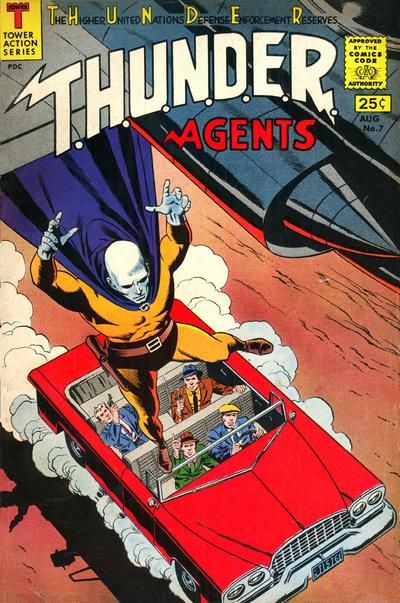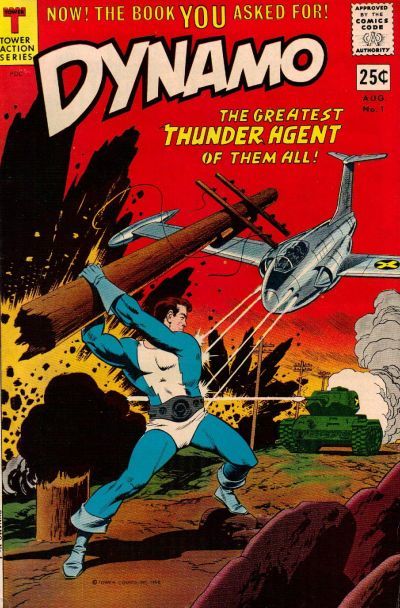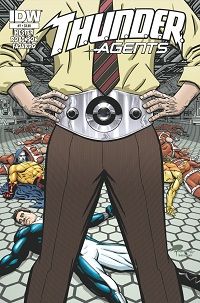T.H.U.N.D.E.R. Agents #7 (1966)
Dynamo #1
T.H.U.N.D.E.R. Agents #7 (2011)
T.H.U.N.D.E.R. Agents #7 (2014)
T.H.U.N.D.E.R. Agents #7 (Tower, 1966, 25¢)
Hey look, another classic Tower issue in my possession! However, I didn't read any of these stories prior to picking up the second volume of DC's T.H.U.N.D.E.R. Agents Archives, so no rosy glow of nostalgia here. This issue had a lot to live up to after the exceptional prior edition, and at least at the start, it seemed like it would meet the standard set there.
The opening Woody Dynamo story had a swell hook, our downtrodden hero reflecting on his being wanted for treason. That would have been a good engine to run a longer story, or even to launch the Dynamo solo series that came out the same month. Too bad they kept things short and simple, a cute ten page yarn that wraps up easily. The story is interrupted by an ad for the "Commander Abdominal Supporter Belt," but that girdle isn't fooling anyone.
There's a lot of good to be said about the Lightning strip. The returning Warp Wizard has a power that believably checks a super-speedster, unlike making rain or champion boomerang throwing. Mike Sekowsky depicts the villainy well, with a particularly suffocating countdown to doom. Steve Skeates' dialogue pops, but if I had to finger a problem, it would be with the writing. This is the second time Skeates has used the same villain in two consecutive installments of the strip, and for every inventive turn taken, there's something dumb that has to happen because the script said so. All in all though, Lightning is one of the book's most consistent entertainers.
"Subterranean Showdown" was weird. The art was credited to George Tuska, but he's barely recognizable. There's a bunch of continuity references in the story, but characterization is way off. Dynamo is an over-eager sexist nitwit, Kitten Kane is a useless coward, and NoMan is cavalier with the life of a fellow agent. The return of Dynavac has potential that is squandered, and a whole new one-time power is invented for an agent to wrap things up. A Dynamo pin-up is repurposed into an ad for his spin-off book, and then Iron Maiden gets her own lovely dossier page by Wood and Dan Adkins. Next up are full page ads for Fight The Enemy and Undersea Agent, then a letters column. An editorial reply noted "Lightning has become tremendously popular."
I guess I spoke too soon about John Giunta taking over Menthor, as he was moved to NoMan after only two months, though it's understandable once you get to the last story of the issue. Before that though, Bill Pearson offers a histrionic Invisible Agent under circumstances that are understandable but uncomfortable with regard to characterization. NoMan basically flips out over the human opportunities he's lost in becoming a supposedly tireless agent. The good is that this is an unusual story for its time which sets NoMan apart from other companies cookie cutter crimefighters, but on the other hand, it kind of invents NoDickery. Giunta appears more comfortable with this character than Menthor, though perhaps the inks of Sal Trapani helped.
Finally, the big one, likely the most highly regarded and oft-noted T.H.U.N.D.E.R. Agents story ever: Menthor in "A Matter of Life and Death!" by Dan Adkins with additional layouts/inks by Wally Wood that render the Steve Ditko pencils barely recognizable as such. It's funny that nobody ever mentions the Ditko part, but you can see it in the body language and the more exaggerated Subterraneans. The story does a good job of pointing out the mishandling of the property to date, including the need for added security measures after John Janus had the Menthor helmet stolen, what, three times in seven issues (with one retrieval spanning two issues?) Where he was once a double agent for the Warlord, that promising angle was forgotten after the second issue, so a new confrontation plays out as straightforward as it would with any other Agent. There's no internal conflict in Janus anymore, and while his physical prowess is again highlighted, it's not enough to get the job done. Dynamo is often compromised, but where he always ultimately works out a "no harm, no foul" remedy, Menthor was only ever a guy in an Atom costume with a less novel gimmick than shrinking. With this story, he serves a higher purpose, and though it's slightly clunky, that only helps to offset the infamous turn it takes toward the end. The somber tone isn't what I read the book for, but this story was a trailblazer that kept its promises.
As I'm sitting here comparing my Archive Edition to my lower grade original copy with light brown pages, I've got to say how much I appreciate DC's superior reproduction. Solid blacks replace grays, muddy flat colors are made both more vibrant and more subtle... unlike many other garish modern reprints I could point to, the Archives work entirely in service to improving the presentation quality of these stories over their initial run. Kudos! By the way, you're only missing out on ads for 200 toy soldier "comic flats," learning to play guitar, and hypnosis.
Dynamo #1 (Tower, 1966, 25¢)
Say, yet another issue I own the original of but have never read before, and like T.H.U.N.D.E.R. Agents #7 this one also has an ad for a "Magic-Scope" on the inside cover and an engaging Dynamo splash page by Wally Wood! Running across the lunar surface while being strafed by a flying saucer? Sold! Shame my opinion on the "traitor" story bares out here. A good chunk of the first portion of this yarn was dominated by NoMan, and considering this is the first story in a new ongoing series, none of the characters are properly introduced to a potential new audience. On the other hand, it was fun to see a tale like this from before man had actually walked on the moon, where the technology and concerns about failure of same are contemporary and realistic. At the same time, matters felt drawn out, there's too many arbitrary developments, and the menace remains shrouded in mystery. If it wasn't for the glorious art, this would have been a sorry way to launch a new book.
"A Day in the Life of Dynamo" seemed off to me. I'm used to Mike Sekowsky on Lightning, and he doesn't feel right on Dynamo, plus his work is buried under Frank Giacoia's inks. The story aims for humor but misses, coming off jingoistic and diminishing a host of prior villains in rapid succession. "Back to the Stone Age" was much better, with a more comfortable, funny script and great art by Reed Crandall and Wood. The team-up of Demo and Dr. Sparta didn't amount to much, as it was Sparta's gimmicks, cast, and characterization that carry most of the tale, but so long as it was a good one, right?
Dynamo had a few different ads from the mother book, including one for its seventh issue and Undersea Agent #4. I have one or two issues of the latter, but I wish someone would reprint them. I'd have rathered DC put them in their Archive Editions instead of the cheaply available upscale format Deluxe series, but maybe IDW will include them in their otherwise redundant current series of trade collections. Also, there's ads for a seven foot replica "Polaris Nuclear Sub" that fired torpedoes, and a life-sized, personally autographed pin-up of David McCallum for $1.
Thanks to Steve Ditko doing full pencils, the layouts on "Dynamo meets the Amazing Andor" are clearly his, despite heavy handed inks from Adkins & Wood. This is a highly unusual story for the line, as it begins twenty years previous, prior to the formation of T.H.U.N.D.E.R., and offers an honest to gosh superhuman. Also, we learn here that there's a whole council of Warlords with a "Mighty Overlord," and individually named Subterraneans. Also, as I guy who's read more revivals than original issues, I'm familiar with prominent mentions of Andor, but had never read an actual story with him. He seems to be like the original Amazing Man taken to the nth degree, which makes him a serious badass who's still vital as an adversary at story's end. He also seems like an attempt to revisit the original Menthor premise and hopefully better see it through this time. My guess is that subsequent publishers held Andor in reserve for later storylines that never materialized in the face of swift, unexpected cancellation. I'll be surprised and disappointed if he doesn't turn up again in the Tower run. My only complaint is that Kitten Kane has forsaken all of her feminist credibility since the T.H.U.N.D.E.R. Squad lost their feature, with Alice Robbins being a more capable, reputable damsel in distress.
Finally, a Weed solo strip, returning to the lighthearted mundanity that's been missing from the Tower comics! After being beaten over the head with the Guy/Kitten relationship dramatics of the '80s series, it's jarring but nice to see Gilbert go out on a date with some random Olga chick. Hey buddy, you may be dying one speeding mission at a time, but you're not dead yet! If that doesn't work out though, room can be made for Weed! John Giunta can't draw sports cars, but he's a fair fit for "Mr. William Wylie" (in case there was any doubt that he was Wallace Wood's analogue.) Nice to see the Agents in a fun story, and even Menthor is redeemed somewhat by a villain who would have been a natural in his strip showing up all of his fellows at once.
T.H.U.N.D.E.R. Agents #7 (DC, 2011, $2.99)
I don't understand the thought process of modern writers. This book presumably licenses the rights to the lyrics of the Dion song "The Wanderer," which "plays" in full on a radio across several pages of a flashback that gives way to more pages of a domestic scenario. Then there's a sequence of violence, and the whole thing is bookended by a page each of basic context. None of it involves much dialogue. Even if this were the storyboard for a movie, that's maybe two minutes worth of finished film. Gave Mike Grell some work, at least.
I assumed the five page back-up strip was drawn by Paul Smith until the credits revealed it was actually Nick Dragotta, which should be taken as a compliment. The strip revisits a dynamic that dated back to the '60s comics and informed the lead story. It's so much more enjoyable and full than the Grell story that by rights they should have switched page lengths.
T.H.U.N.D.E.R. Agents #7 (IDW, 2014, $3.99)
I seriously thought that with IDW behind it, this volume of T.H.U.N.D.E.R. Agents might reach and exceed the longevity of the Tower original. Instead, I finally realized they had quietly canceled the book with the eighth issue only after it had gone months without new solicitations. It's not like they had the smartest business plan anyway, reprinting the old comics that DC had already reprinted in readily available Archive Editions, only marginally cheaper and with questionable extras (vintage ads? Whoopee.) DC caught the edgy Nick Spencer just as he was getting noticed, while Phil Hester is a veteran without any heat doing a fairly traditional super-hero book. Coupled with the licensing fees for Radiant Assets, LLC, whoever the hell they are, it's no wonder the ongoing turned mini-series double quick.
Last issue ended on a cliffhanger that cut to the core of the team's lore, and I wonder how far in advance Hester knew he needed something big enough to draw the volume down. After reading the Dr. Sparta story in Dynamo, I wonder if the kid here was originally supposed to be Wilbur and his elder Sparta. While the script was well done, in retrospect it's odd that Hester referenced an Undersea Agent and introduced an all new Lightning (did he ever get named?) plus revisited John Janus and Dr. Sparta in these last issues only to return the story to the ancient towers that dominated the first four issue arc. This issue was exceptionally busy with turnabouts and cross-cutting. I continue to enjoy Roger Robinson's art, especially his use of tones little seen since computer coloring took over shading. I have some issues with changes Hester made, but seeing the potential of the book and some smart decisions that were made, I'm sorry to see it go so soon.
I'll have to stop complaining about the Subscription variant covers, because at least they offer a choice. If I recall correctly, the gorgeous Jerry Ordway variant I got was used in the solicitations, whereas I don't believe the standard Roger Robinson was, and that's a whole lot more businessman crotch than I'm game for.





